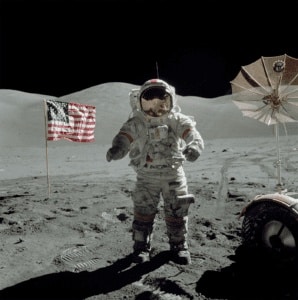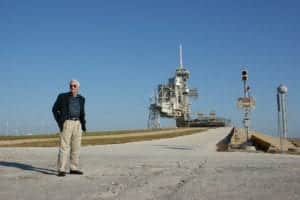The Last Man on the Moon

Astronaut Gene Cernan, subject of the documentary “The Last Man on the Moon,” on the surface of the moon in 1972.
“America’s challenge of today has forged man’s destiny of tomorrow. And, as we leave the moon…we leave as we came and, God willing, as we shall return, with peace and hope for all mankind.”
Apollo 17 Commander Eugene Cernan spoke those words from the surface of the moon on December 13, 1972, and when he boarded the lunar module for the last time, he didn’t know that over four decades later, none would have followed in his dusty footprints. Cernan understands clearly that the effects of going to the moon are long-lasting, even life-changing.
“Imagine sitting on a soft swing on God’s front porch,” he said. “Looking back at the Earth and its beauty – the blues of the oceans, the whites of the snow and clouds, surrounded by the blackest black you can conceive in your mind with thousands and thousands of stars – it was just absolutely incredible.”

Cernan with director Mark Craig.
Cernan is the subject of “The Last Man on the Moon,” a documentary directed by Mark Craig, based on Cernan’s autobiography of the same name. “The Apollo era was a really exciting, inspiring one, and there was a lot of space-related consumer goods around,” he recalled. “But I also vividly remember one day at school in 1972 when our teacher told us that we were the generation that would one day be able to travel into space and to the moon for our holidays! Such was the speed of development at that time that anything seemed possible … but of course it didn’t pan out that way, and Gene Cernan is still the last man to have walked on the moon.” Craig had read other astronaut biographies and was interested in the idea of a documentary on space travel, but it wasn’t until he read Cernan’s book that everything clicked. “I thought Gene’s book was so much more personal, humorous and revealing than any other,” he noted. “The story itself included so many dramatic moments and plot twists, that before I’d even finished reading it I had become gripped with the idea of making a documentary movie of it. Everything about it just clicked with my own sensibilities as a film-maker.”
The process started with Craig’s email to Cernan’s publisher in 2006, but filming didn’t begin until October 2012. “It took a sustained effort over several years to convince Gene that such a documentary could work, and that me and my producing colleagues were the right team to do the job,” Craig recalled. The film contrasts Cernan’s life today with his past as an astronaut, and new footage was shot by BAFTA-winning cinematographer Tim Cragg. “Weaved into this are interview contributions from many others close to him, personal home movies, artifacts, and of course some wonderful archive footage that was sourced from NASA,” he continued. With a wealth of material at his fingertips, Craig admitted that choosing what to include was the most difficult part of the process. A scene of Cernan riding horses with longtime friend Fred ‘Baldy’ Baldwin is a favorite of Craig’s, as is the Apollo 10 launch, with Cernan going through the intense moments leading up to it. “One can only imagine what it’s like to be bracing yourself for your first ride on the biggest, baddest vehicle that ever flew,” he said.

Cernan revisited many key locations in his journey to the moon for the documentary, including Cape Canaveral, some 40 years after his time there. Photos courtesy of Gene Cernan and Mark Craig.
“I wanted to take Gene back to key locations that had played a big part in his life, like the Kennedy Space Centre, San Diego, the old Houston home from his astronaut days, Arlington National Cemetery, and of course his beloved ranch, where we could capture the man as we’d never seen him before,” Craig said. “But as well as an intimate portrayal of Gene, I also wanted to maximize the majestic setting of space, and so his missions are portrayed in a way that’s perhaps a little inspired by Stanley Kubrick’s 2001, A Space Odyssey, especially Apollo 10 – which tends to be a somewhat forgotten mission in light of what followed.”
Craig cites the human desire to learn and explore for continued passion for and interest in the space program. “The boundaries of space as far as exploration is concerned are quite limitless. Humans have been inspired by planets, moons and stars from the outset, always searching, asking questions and finding new answers,” he said. “Most inspiring of all are the voyages into space by humans – and to a lesser degree, robots. Don’t get me wrong, some truly remarkable unmanned technology has been sent into space, but as Gene Cernan would say: ‘No one ever gave a robot a ticker tape parade!’ It’s the human endeavor, with all the inherent risks that go with it, that really captures the public’s imagination.”
Related Stories
Cheers to 20 Years
Six members of Team Jet Linx celebrate two decades of Five-Star service.
READ MORE
Immerse Yourself
More than 40 years after pioneering one of the first health and wellness resorts in Tucson, AZ, Jet Linx Elevated Lifestyle partner Canyon Ranch continues to redefine what wellness-focused getaways can offer.
READ MORE
What Kind of Caviar Are You?
Whether you are a caviar newbie or a seasoned connoisseur, Jet Linx Elevated Lifestyle partner Petrossian has a caviar for your tastes.
READ MORE
Related Stories
Cheers to 20 Years
Six members of Team Jet Linx celebrate two decades of Five-Star service.
READ MORE
Immerse Yourself
More than 40 years after pioneering one of the first health and wellness resorts in Tucson, AZ, Jet Linx Elevated Lifestyle partner Canyon Ranch continues to redefine what wellness-focused getaways can offer.
READ MORE
What Kind of Caviar Are You?
Whether you are a caviar newbie or a seasoned connoisseur, Jet Linx Elevated Lifestyle partner Petrossian has a caviar for your tastes.
READ MORE



Contact Us